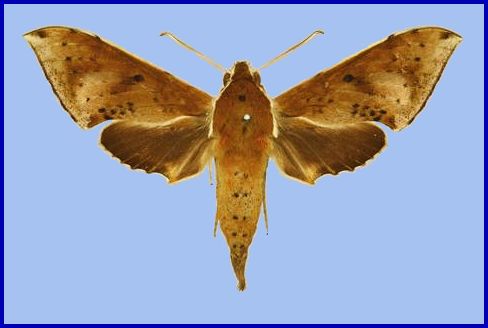
Metopsilus albomarginatus Rothschild, 1894, Novitates Zoologicae 1: 78. Type locality: [India,] Assam [Meghalaya], Khasia Hills [Khasi Hills] [NHMUK]. There is a female in the CMNH labelled 'paratype' from 'Khasia Hills, Assam, 3/6'; it has yet to be determined whether this specimen has type status.
Synonym. Chaerocampa velata Hampson, 1896 (non Walker, 1866).
Synonym. Rhagastis olivacea Manson, 1921 (non Moore, 1872).
Synonym. Rhagastis albomarginatus nubilosa Bryk, 1944.
In the male, head grayish black; thorax blackish gray, with two creamy white stripes dorsally; abdomen upper side black, lateral side with orange hair, underside grayish white. Forewing elongated, apex sharply pointed, outer margin protruding, distal portion of inner margin slightly concave; upper side ground color dark gray-brown, middle area with black zigzag dotted lines and a black patch near the tornus, a yellow–white oval patch across the postmedian lines, a triangular deep gray patch near the apex, the submarginal area covered by a grayish patch, a discal spot near a large black patch. Forewing underside yellow peppered with gray spots, the postmedian line a black dotted line, the large black patch at base connected to a grayish patch covered on the submarginal area with a gray thick line. Hindwing dark brownish, tornus with a yellow-brown patch; underside yellow peppered with gray spots, the postmedian line a black dotted line, the discal spot a black solid circle, the medial line a grayish zigzag line. The female is similar to the male but with broader wings and a slightly paler and darker ground color and a more obvious grayish zigzag medial line on the underside of the forewing and hindwing (Jiang et al., 2024).
In the male genitalia, the uncus and gnathos form a typical macroglossine 'birdbeak' structure. Uncus straight, with a tiny apical hook. Gnathos slightly thicker than uncus; apex blunt. Valva rounded, with the basal part almost equaling the width of the terminal part; apex blunt. Sacculus slightly constricted and obviously curved upward apically into the harpe. The phallus is short and straight, with the anterior lobe of the process ending in a slender transverse hook with apical spinules (Jiang et al., 2024).
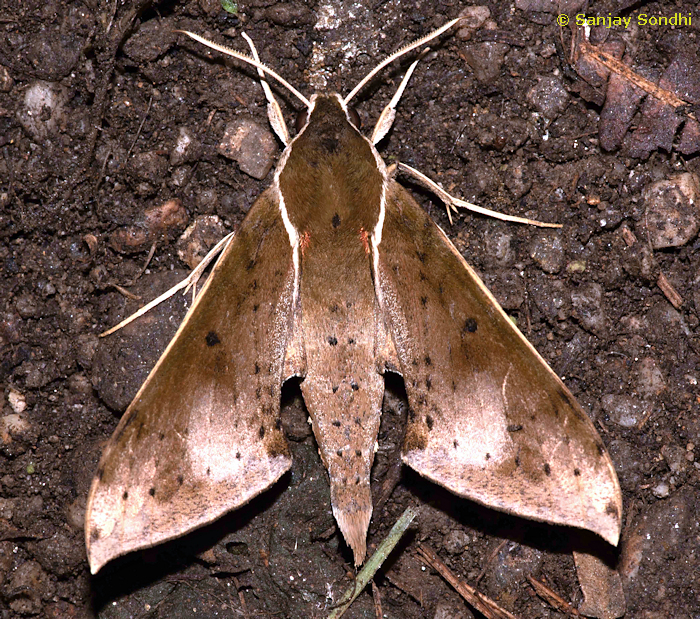
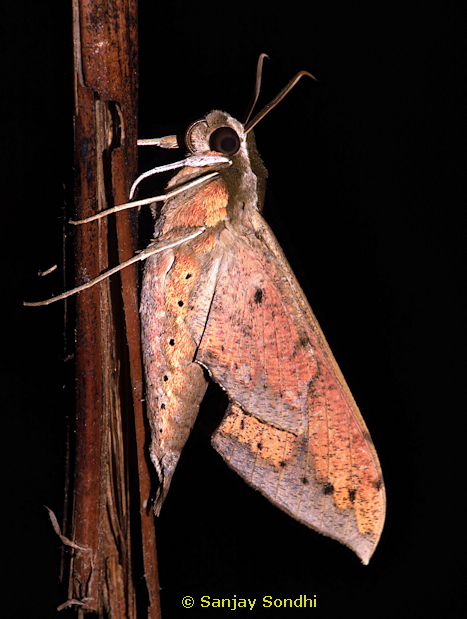
China: v (Xizang/Tibet); vi (Yunnan); viii (Yunnan).
OVUM: Pale yellowish.
LARVA: Full-fed 100mm., width 15mm.; horn 8mm. According to Bell & Scott (1937), the first instar is pale honey-yellow, with a short, straight, black horn; surface of body very smooth and shiny. In the second instar, head pale blue; body green, with a shiny and translucent appearance; segment five tumid; an eye-spot on segment five black edged with white; horn pale blue. By the third instar, body dotted with yellow; a dorso-lateral and a sub-spiracular stripe on segments 2 to 4, and oblique stripes on 6 to 11 pale blue; an eye-spot on segment five, which is very tumid, pupil pale blue edged broadly with white and narrowly with black; this eye-spot shiny and conical; horn dark blue. In the fourth instar, with a dark blue dorsal stripe; horn down-curved, smooth and shiny, clubbed at the tip.
In the fifth and final instar, shape the same as others of the genus. Head dull and smooth. Body shiny as though enamelled, including the eye-spot and horn. The latter of medium length, thick at base, proximal half tapering sharply, then cylindrical to near the slightly bulbous tip, bent slightly downwards in the middle. In colour, head pale blue, body pale yellowish in dorsal area, lateral area pale grass-green or bluish-green with a number of short, longitudinal, dark green lines across the secondary rings, turning to bluish dots below the spiracles and on venter; a narrow, broken, dark green dorsal stripe from segment two to base of horn; a broad, pale blue or whitish dorso-lateral stripe on segments 2 to 4; a similar sub-spiracular stripe on 2 to 4, meeting at a sharp angle the lower end of the oblique stripe on segment 5; eye-spot on 5 round or obliquely oval, conical in shape, the small pupil, at the apex of the cone, deep blue; it is edged broadly with very pale blue, this again edged broadly with white, the whole edged narrowly with black; broad pale blue oblique stripes on segments 5 to 12, each running through the spiracle and forwards on to the segment in front and back on to the segment behind, that on 11 running across 12 to base of horn, that on 12 narrower than the rest and stopping just behind the spiracle. Horn dark blue with a series of darker blue, narrow rings from near base to tip; legs, prolegs, anal flap and claspers pale blue. Spiracles ochreous. There is no dark-coloured form, though some individuals are of a darker shade of green than others. When alarmed, the anterior segments are strongly retracted into segment five, which then becomes very swollen. The bright colouring, the shiny enamel-like surface and the protruding conical eye-spots, looking like a pair of staring eyes, give the larva a very striking appearance (Bell & Scott, 1937).
Bell & Scott (1937) state that in India the larvae were very voracious feeders, and being extremely common at Shillong (Khasi Hills, Meghalaya), hydrangea bushes there were frequently stripped of all their leaves. One bush which was kept under observation was so stripped three times in one season, eggs were laid on the fresh shoots as soon as they appeared. Every season immense numbers of larvae were destroyed by gardeners, and by ants when, having stripped one bush, they were compelled to come to the ground to seek other food. In spite of this annual destruction, no diminution in the numbers of larvae was noticed during a period of ten years. They also appeared to be singularly immune from attacks by parasitic wasps and flies.
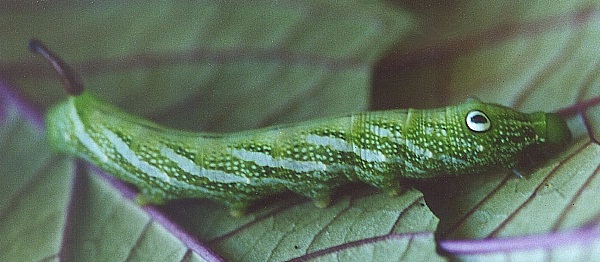
PUPA: 55mm., width 11mm.; cremaster 3mm. Tongue-sheath more prominent ventrad than frontad. Surface dull and smooth except for rounded tubercles on veins of wing-case and legs. Cremaster triangular, ending in two shafts which are broad and coalescing at base, each shaft ending in a weak incurved spine and a longer, stronger, outcurved spine; there is a dorso-lateral spine near base of cremaster and another about half-way between base and tip, each ending in two minute hooks; upper surface of cremaster shagreened, lower surface deeply longitudinally grooved. Head, thorax and wing-case pale brown, darker on dorsum; the tubercles on legs and veins dark brown; abdomen ochreous with paler patches above and below the spiracles, which are dark brown; bevels of free abdominal segments reddish; shaft and spines of cremaster black (Bell & Scott, 1937).
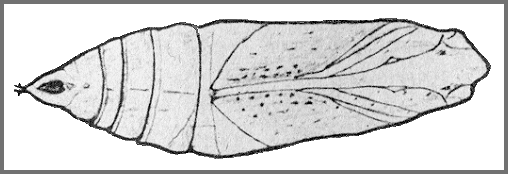

Larval hostplants. Species of Hydrangea in the Khasi Hills, Meghalaya, India (Bell & Scott, 1937). Also Dichroa and Vitis (Jiang et al., 2024).
Unknown.
China: Xizang/Tibet (Motuo/Metok/Mêdog/Pemako, 1200m); Yunnan (Malipo, 1310-1450m; Jingdong; Changning County, Songzhishanding, 2800m; Gaoligong Shan; Lincan County, Daxueshan; Xima, 1500m; Jingdong, Pu'er, 2150m); Guangxi; Hainan.
Nepal, Bhutan (Irungbam & Irungbam, 2019), northeastern India, tropical southern China, northern Vietnam (Le & Vu, 2024), northern Laos, northern Thailand, and northern Myanmar/Burma.
[Previously recorded from Peninsular Malaysia, Sumatra, Java and Borneo. This population has now been reclassified as Rhagastis everetti Rothschild & Jordan, 1903 (Jiang et al., 2024).]
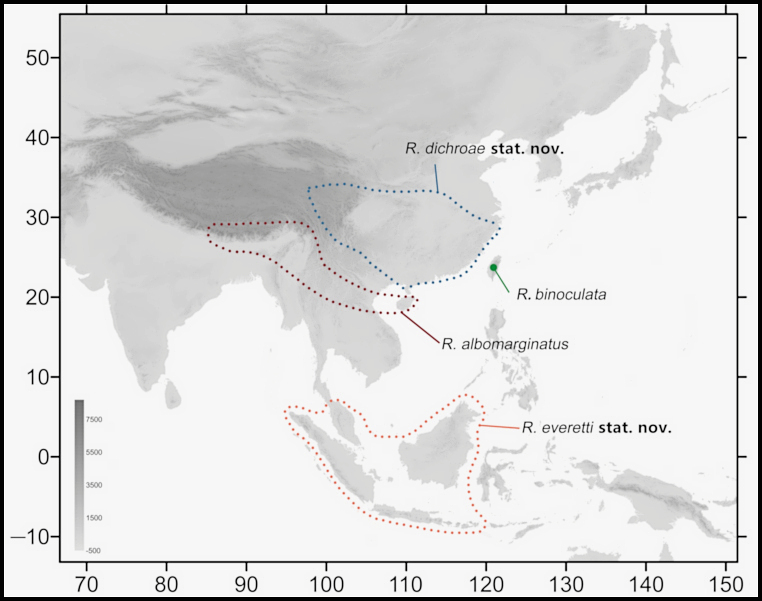
Map: Distribution of species of the albomarginatus group of the genus Rhagastis. The blue dotted line indicates the range of R. dichroae, the red dotted line indicates the range of R. albomarginatus, the orange dotted line indicates the range of R. everetti, and the green circle indicates the range of R. binoculata (© Jiang, Wang, Xu, Kitching, Huang, Hu & Xiao, 2024).
 Return to Sphingidae of the Eastern Palaearctic species list
Return to Sphingidae of the Eastern Palaearctic species list